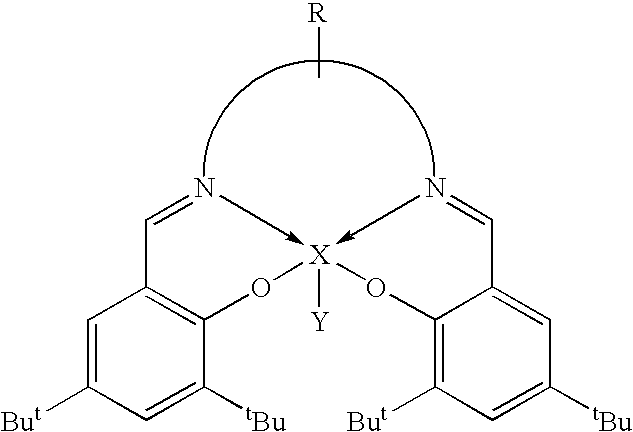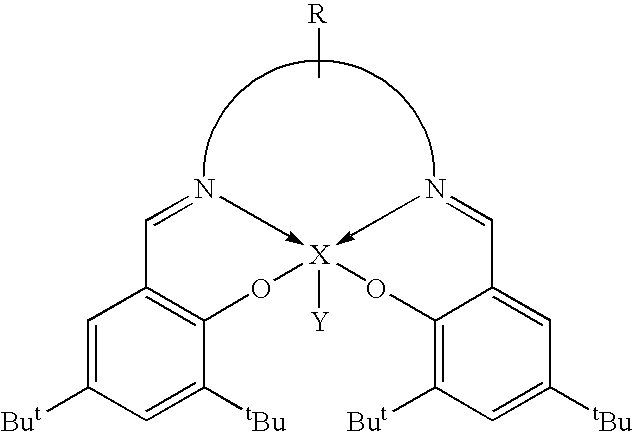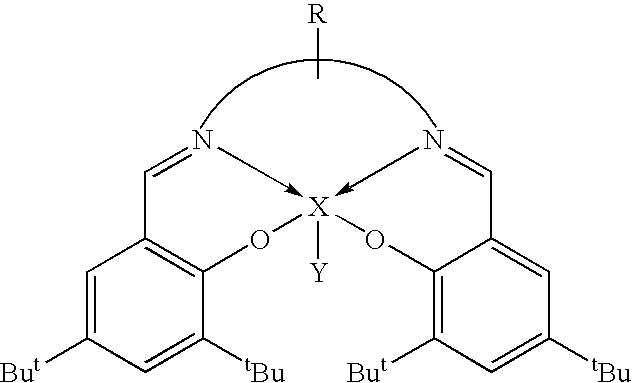Cleavage of phosphate ester bonds by use of novel group 13 chelate compounds
a phosphate ester bond and compound technology, applied in the field of new compounds, can solve the problems of destroying such compounds, affecting the neurological function of cells, and affecting the toxicity of chloropyrifos, paraoxon and parathion, and causing the destruction of such compounds of great environmental concern
- Summary
- Abstract
- Description
- Claims
- Application Information
AI Technical Summary
Benefits of technology
Problems solved by technology
Method used
Image
Examples
example 1
Synthesis of salen(tBu)AlBr
[0040]To a rapidly stirred solution of Et2AlBr in toluene, prepared in situ by the redistribution of triethyl aluminum (0.42 g, 3.60 mmol) and aluminum(III) bromide (1M solution in, dibromomethane 1.8 mL, 1.80 mmol), a solution of salen(tBu)H2 (2.69 g, 5.46 mmol) in toluene was cannula transferred. The reaction mixture was refluxed for 8 hours and filtered. The volatiles were removed under vacuum from the clear yellow filtrate to give a yellow microcrystalline solid which was purified by recrystallization from toluene. Single crystals suitable for X-ray analysis were grown from slow diffusion of hexane vapor into a concentrated CH2Cl2 solution of salen(tBu)AlBr. Yield: 2.69 g (73.8%). Mp: 330–332° C. (dec.). 1H NMR (CDCl3): δ 1.33 (s, 18H, C(CH3)3), 1.57 (s, 18H, C(CH3)3), 3.97 (m, 4H, NCH2), 7.08 (d, 2H, PhH), 7.60 (d, 2H, PhH), 8.40 (s, 2H, N═CH); 13C NMR (CDCl3): δ 29.7 C(CH3)3), 31.3 (C(CH3)3), 34.0 (CCH3)3), 35.5 (CCH3)3), 54.5 (NCH2), 118.2 (Ph), 127...
example 2
Synthesis of salpen(tBu)AlBr
[0041]To a rapidly stirred solution of Et2AlBr in toluene, prepared in situ by the redistribution of triethyl aluminum (0.24 g, 2.08 mmol) and aluminum(III) bromide (1M solution in, dibromomethane 1.0 mL, 1.00 mmol), a solution of salpen(tBu)H2 (1.57 g, 3.10 mmol) in toluene was cannula transferred. The reaction mixture was refluxed for 17 hours. The cloudy yellow solution was concentrated under vacuum to about one third of its volume. The yellow precipitate was isolated by cannula filtration, washed with ˜15 mL of hexane, dried under vacuum and recrystallized from toluene. X-ray quality crystals were grown from slow diffusion of hexane vapor into a concentrated CH2Cl2 solution of salpen(tBu)AlBr. Yield: 1.04 g (55%). Mp: 333–334° C. (dec.). 1H NMR (CDCl3): δ 1.30 (s, 18H, C(CH3)3), 1.50 (s, 18H, C(CH3)3), 2.23 (m, 2H, CH2CH2CH2), 3.85 (m, 4H, NCH2), 7.07 (d, 2H, Ph—H), 7.56 (d, 2H, Ph—H), 8.29 (s, 2H, N═CH); 13C NMR (CDCl3): δ 27.2 (CH2), 29.7 (C(CH3)3),...
example 3
Synthesis of salophen(tBu)AlBr
[0042]To a rapidly stirred solution of Et2AlBr in toluene, prepared in situ by the redistribution of triethyl aluminum (0.21 g, 1.08 mmol) and aluminum(III) bromide (1M solution in dibromomethane, 0.90 mL, 0.90 mmol), a solution of salophen(tBu)H2 (1.46 g, 2.70 mmol) in toluene was cannula transferred. The golden yellow solution was refluxed for 15 hours. Then it was concentrated under vacuum to about one third of its volume. Yellow crystals precipitated after cooling at −30° C. for 24 hours. The crystals were isolated by cannula filtration, washed with hexane and dried under vacuum. Yield: 1.54 g (88%). Mp: 320° C. (dec.). 1H NMR (CDCl3): δ 1.37 (s, 18H, C(CH3)3), 1.63 (s, 18H, C(CH3)3), 7.24 (d, 2H, Ph—H), 7.35 (m, 2H, Ph—H), 7.66 (m, 2H, Ph—H), 7.71 (d, 2H, Ph—H), 8.94 (s, 2H, N═CH); 13C NMR (CDCl3): δ 29.8 (C(CH3)3), 31.2 (C(CH3)3), 34.1 (C(CH3)3), 35.6 (C(CH3)3), 115.4 (Ph), 115.7 (Ph), 118.5 (Ph), 126.7 (Ph), 127.5 (Ph), 128.2 (Ph), 129.1 (Ph), 13...
PUM
| Property | Measurement | Unit |
|---|---|---|
| density | aaaaa | aaaaa |
| corrosive | aaaaa | aaaaa |
| covalent | aaaaa | aaaaa |
Abstract
Description
Claims
Application Information
 Login to View More
Login to View More - R&D
- Intellectual Property
- Life Sciences
- Materials
- Tech Scout
- Unparalleled Data Quality
- Higher Quality Content
- 60% Fewer Hallucinations
Browse by: Latest US Patents, China's latest patents, Technical Efficacy Thesaurus, Application Domain, Technology Topic, Popular Technical Reports.
© 2025 PatSnap. All rights reserved.Legal|Privacy policy|Modern Slavery Act Transparency Statement|Sitemap|About US| Contact US: help@patsnap.com



